Your 1969 penny could be worth a fortune if it’s the double-die obverse variety. Even if it’s not a double die, it could still be worth a decent amount. This article explains and gives the values of different grades and varieties of the 1969 cent. It also includes some background information on the coin.
The 1969 penny is a plain edge, round coin of 19 mm diameter, 3.11g weight, and made of 95% copper a5% zinc. It is the 11th coin in the reverse Lincoln penny series of 1959 -1982. It features the image of US President Abraham Lincoln on the obverse and the Lincoln Memorial building on the reverse. At the time of issue, the 1969 penny had a mintage of over 5.5 billion.
1969 Penny: Grades and Values
| 1969 Penny Grade and Value | |||
| Regular Strike | Brown (BN) | Red and Brown (RB) | Red (RD) |
| No mint mark | – | – | $6 – $575 |
| D penny | $2 | $2 – $8 | $5 – $325 |
| S penny | – | – | $8 – $350 |
| ‘S’ double die obverse | $13000 – $41,000 | $30,000 – $60,000 | $31,500 – $605,000 |
| 1969 Proof Penny Grade and Value | |||
| Proof coin | PR RD | PR CAM | PR DCAM |
| ‘S’ proof | $2 – $28 | $3 – $60 | $4 – $625 |
Due to the sheer number and the age (54 years) of this coin, there is still a lot of it around and this has a direct impact on the value. A lot of the circulated coins are only worth a couple of cents, not much more than the face value or the melt value of $0.0254.
Only red pennies of grades MS60 or higher as well as the proof coins have any real numismatic value. The only exception is the double die obverse variety which is both uncommon and very sought after.
Lower circulated grades of this variety go for an impressive $13,000 for low-grade brown coins, $60,000 for uncirculated red-brown coins, and a staggering $605,000 for red gems graded at MS67 and above.
1969 No Mint Mark (P) Penny: Value and Grading
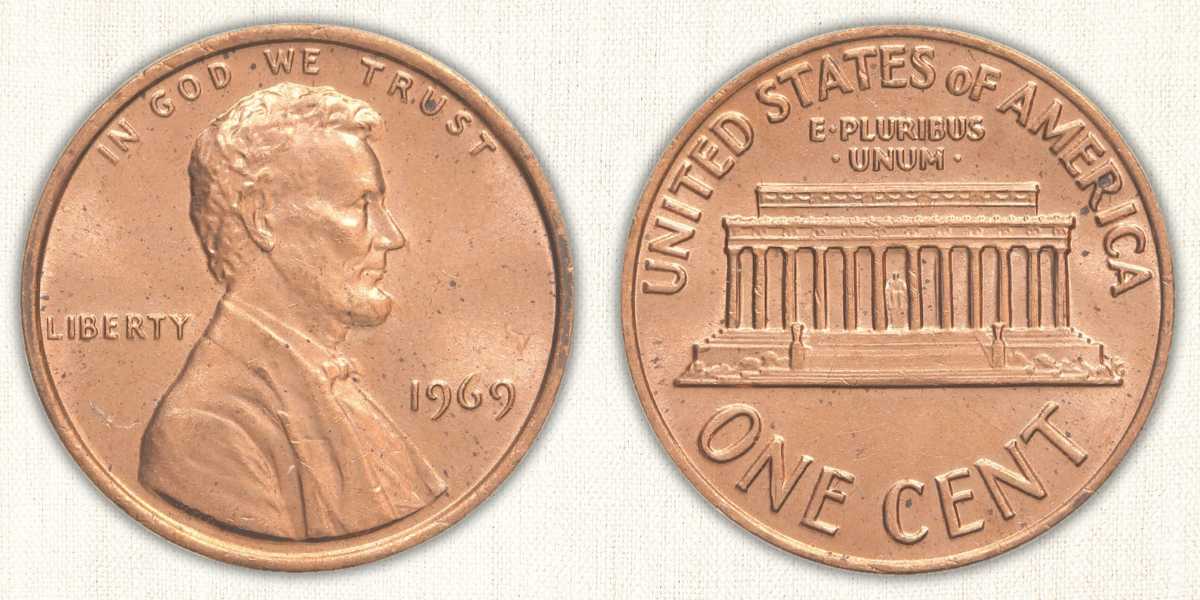
The “no mint mark” 1969 penny was minted in Philadelphia, and like a lot of coins from the Philadelphia mint, this one did not have a mint mark. Over 1 billion of these “no mint mark” 1969 pennies were released, out of which PCGS estimates that at least 113 million still exist in mint condition and higher.
So the coin is rather common, and the lack of rarity impacts the value. A red MS63 grade 1969 penny is worth $6, while a near-perfect red MS67 is worth $575.
If a moderately high-quality red 1969 penny is worth only $6, it means that brown and red-brown coins, regardless of grade, have little or no value.
But despite the low numismatic value, the auction record for the 1969 penny stands at an impressive $5,750. This was the amount paid for a red gem MS67 1969 penny auctioned by Bowers and Merena in Baltimore, June 2010.
1969 No Mint (P) Penny: Grade and Value Chart |
|
| Grade | Red (RD) |
| MS 63 | $6 |
| MS 64 | $12 |
| MS 65 | $20 |
| MS 66 | $44 |
| MS 66+ | $185 |
| MS 67 | $575 |
1969-D Penny: Grading and Value
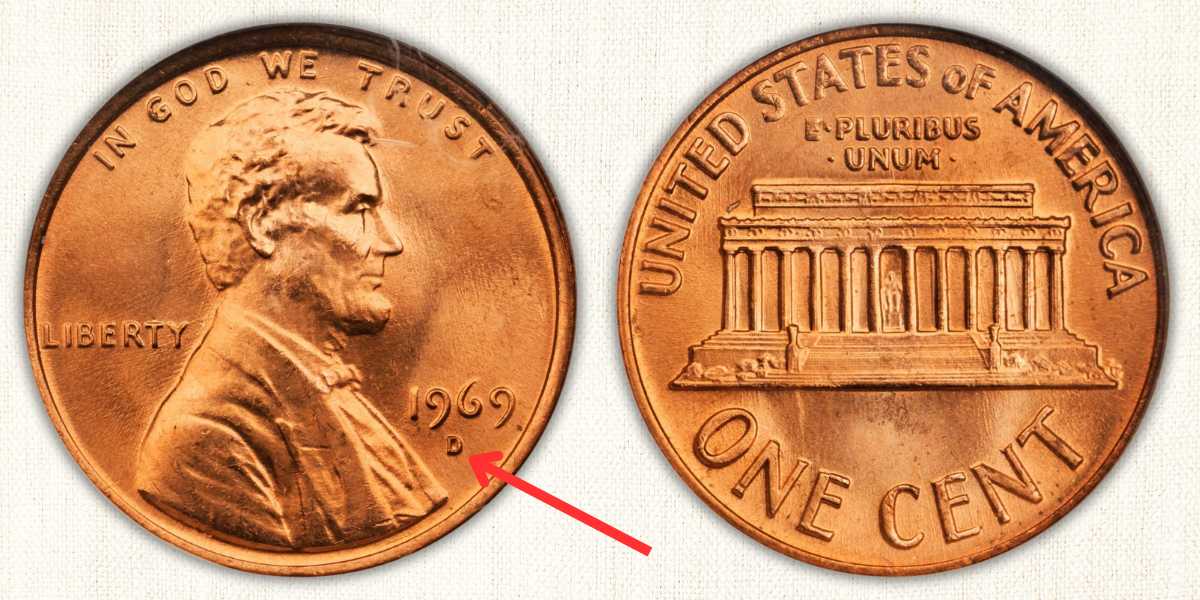
1969 Lincoln one-cent pieces with a “D” mark under the date are coins minted in Denver. Approximately 4 billion of these “D” pennies were released in 1969, by far the highest amount of pennies produced by any minting facility that year.
It’s estimated that at least 400 million uncirculated 1969-D pennies still survive in the possession of coin collectors, and numismatists across the US. As such, the coin has a low numismatic rarity.
Additionally, many 1969-Denver pennies are of lower quality compared to the pennies from the Philadelphia and San Francisco mints. The low quality was likely due to improper planchet preparation, resulting in the coins having uneven luster.
As you would expect, the combination of low rarity and low quality will result in low value.
The 1969–D pennies have the lowest values, of all varieties of the 1969 penny. High-grade MS66 brown, MS66 red-brown, and MS66 red coins are worth $2, $8, and $40 respectively. And a red gem “D” penny is worth $325.
Surprisingly, the auction record for this coin is higher than the Philadelphia variant, despite having marginally lower numismatic values. In August 2010, Heritage Auctions auctioned a red MS67 1969-D penny for $7,475.
1969-D Penny: Grade and Value chart |
|||
| Grade | Brown (BN) | Red and Brown (RB) | Red (RD) |
| MS 63 | – | $2 | $5 |
| MS 63+ | – | $2 | $6 |
| MS 64 | $2 | $3 | $8 |
| MS 65 | $2 | $4 | $20 |
| MS 65+ | – | $6 | $25 |
| MS 66 | $2 | $8 | $40 |
| MS 66+ | – | – | $70 |
| MS 67 | – | – | $325 |
1969-S Penny: Grading and Value

Another variant of the 1969 one-cent coin is the one from the San Francisco mint, easily identified by the letter ‘S’ under the date. These S coins had the lowest mintage of the 1969 Lincoln cent, at just over 544 million coins. For context, that’s about 13% of the Denver penny.
Despite the comparatively lower mintage, the 1969-S penny is not considered a rarity. As such, only high-grade uncirculated coins are valuable. The value of the 1969-S penny ranges from $8 for a red MS63, $20 for a red MS65, and $350 for MS67.
These values are similar to those of corresponding grades of other variants ( P and D) of the 1969 Lincoln. Even the auction record of $4,406.25 by Heritage Auctions in 2014 is relatively proportional to the $5,750 auction record of the no-mark 1969 penny.
1969-S: Penny Grade and Value Chart |
|
| Grade | Red (RD) |
| MS 63 | $8 |
| MS 64 | $15 |
| MS 65 | $20 |
| MS 66 | $34 |
| MS 67 | $350 |
1969-S Penny Double Die Obverse: Grade and Value
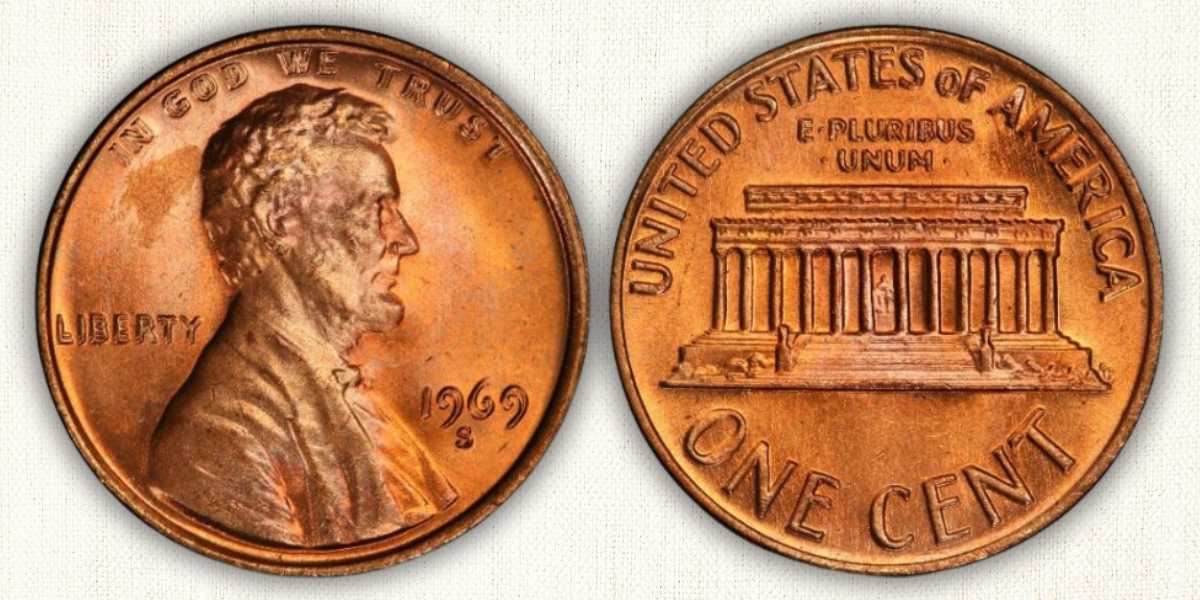
The double die obverse is yet another variant of the 1969 Lincoln cent coin. Or more precisely, it is a variant of a variant, as these coins are part of the 544 million minted by the San Francisco mint, and as such they also carry the ‘S’ mark under the date.
The exact number of these double-die coins is unknown, but they are very rare, and it’s always news when a new one is discovered.
Double-die pennies can be identified by visible doubling on the date and all the lettering on the obverse of the coin, especially the word “LIBERTY.” However, the S mint mark may have a weak doubling or none at all.
It’s important to note that this isn’t an official variety, as the San Francisco Mint did not deliberately make the coins this way. Double-die coins, despite their high value, are technically a minting error.
A 1969-S penny double die penny is very valuable and even low-grade specimens can fetch a premium. Prices range from $13,000 for a mid-range brown coin, to as high as $605,000 for an MS66 red.
The auction record for this coin is $126,500 for a red MS64. The coin was auctioned by Heritage Auctions, in January 2008.
1969 Double Die Obverse: Grade and Value Chart |
|||
| Grade | Brown (BN) | Red and Brown (RB) | Red (RD) |
| VF 35 | $13,000 | – | – |
| XF40 | $13,500 | – | – |
| XF 45 | $14,000 | – | – |
| AU 50 | $14,500 | – | – |
| AU 55 | $20,000 | – | – |
| MS 60 | $28500 | $30,000 | $31,500 |
| MS 61 | $30,000 | $34,000 | $36,000 |
| MS 62 | $35,000 | $36,000 | $38,000 |
| MS 62+ | $36,500 | $40,000 | $41,500 |
| MS 63 | $41,000 | $46,000 | $48,500 |
| MS 64 | – | $60,000 | $62,500 |
| MS 65 | – | – | $250,000 |
| MS 65+ | – | – | $315,000 |
| MS 66 | – | – | $605,000 |
1969 Proof Penny: Grade and Value

Proof coins for the 1969 pennies were made in San Francisco. As a result, all proofs carry the ‘S’ mint mark.
About 2.9 million proofs were produced, and it’s estimated that more than 748 thousand of these are still in uncirculated mint state.
1969 proofs are not very rare, and can even be bought online for prices ranging from $2 for a regular proof penny to $625 for a coin of grade PR 69DCAM.
Generally speaking, proof coins, especially the highest-graded DCAM specimens, are a lot more valuable than uncirculated (MS) coins. But that doesn’t seem to be the case here.
Indeed, the auction record for a 1969-DCAM-proof penny is $1,705 by Heritage Auctions in 2010. This amount is significantly less than the auction records for the different mint mark options of the 1969 MS coins.
1969 Proof: Grade and Value Chart |
|||
| Grade | Red (RD) | Cameo (CAM) | Deep Cameo (DCAM) |
| PR 60 | $2 | $3 | $4 |
| PR 61 | $3 | $4 | $5 |
| PR 62 | $4 | $5 | $6 |
| PR 63 | $6 | $10 | $12 |
| PR 64 | $6 | $12 | $15 |
| PR 65 | $7 | $15 | $22 |
| PR 66 | $8 | $16 | $27 |
| PR 67 | $12 | $20 | $32 |
| PR 68 | $20 | $30 | $70 |
| PR 69 | $28 | $60 | $625 |
1969 Lincoln Penny Error Coins
Just like the actual 1969 cent isn’t uncommon, error coins are also not rare, and all mint marks have error specimens, though the D coins seem to have the greater proportion.
Here is a list of some types of coin errors you may see on a 1969 penny
- No FG mark and Floating roofs
- Off-center strikes
- Double strikes
- Curved clip
- Broken die
- Broad strike, out of collar
- Dropped letter
1969 D Penny with No FG and Floating Roof Errors
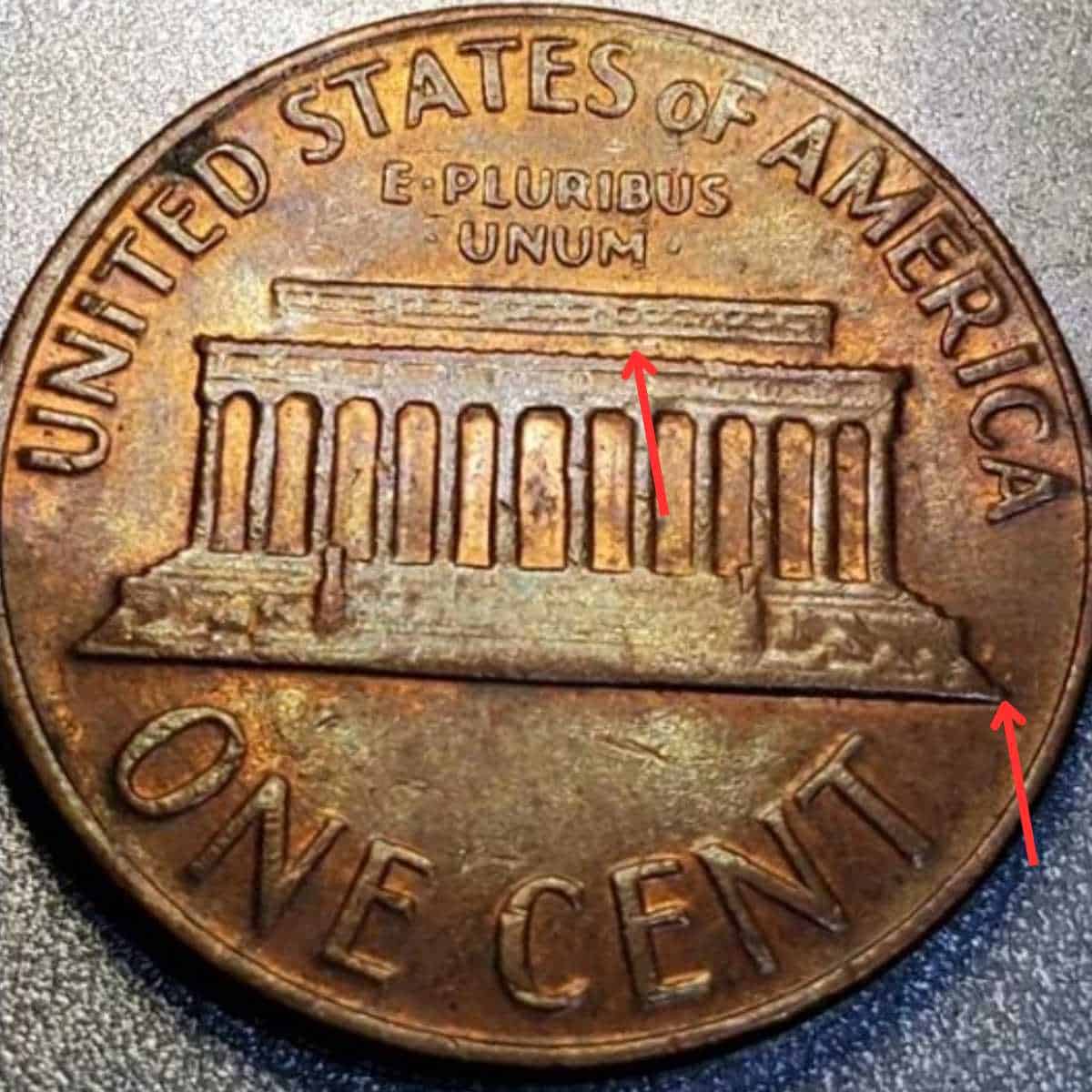
Valued at $134, this 1969-D Lincoln penny has a mix of two errors that appear on the reverse. First, is the missing FG initials which should typically appear at the right edge of the memorial building. The second error is that the roof of the memorial building appears to float.
Both errors were caused by die abrasion or overpolishing, which removed the details that would normally have given the coin the FG initial and a full roof.
1969 S Penny with Struck Through Grease Error
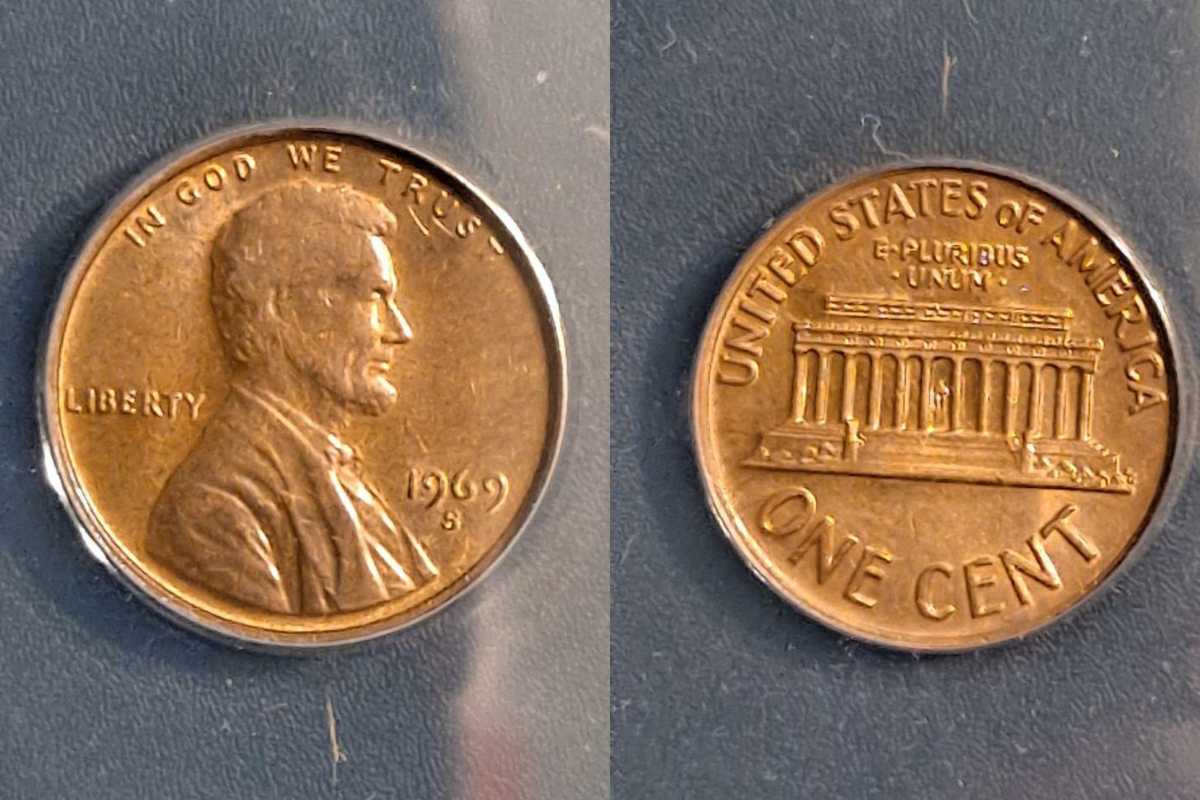
Here’s a red 1969-S penny, Ammex authenticated as struck through grease. The coin shows a slightly blurred-out image of Lincoln on the obverse.
This error was a result of grease in the die when the coin was struck, thus reducing the intensity of the strike and producing a blurred image. The coin is graded MS63-RD and priced at $49.77
1969 D Penny with Struck 40% Off Center Error
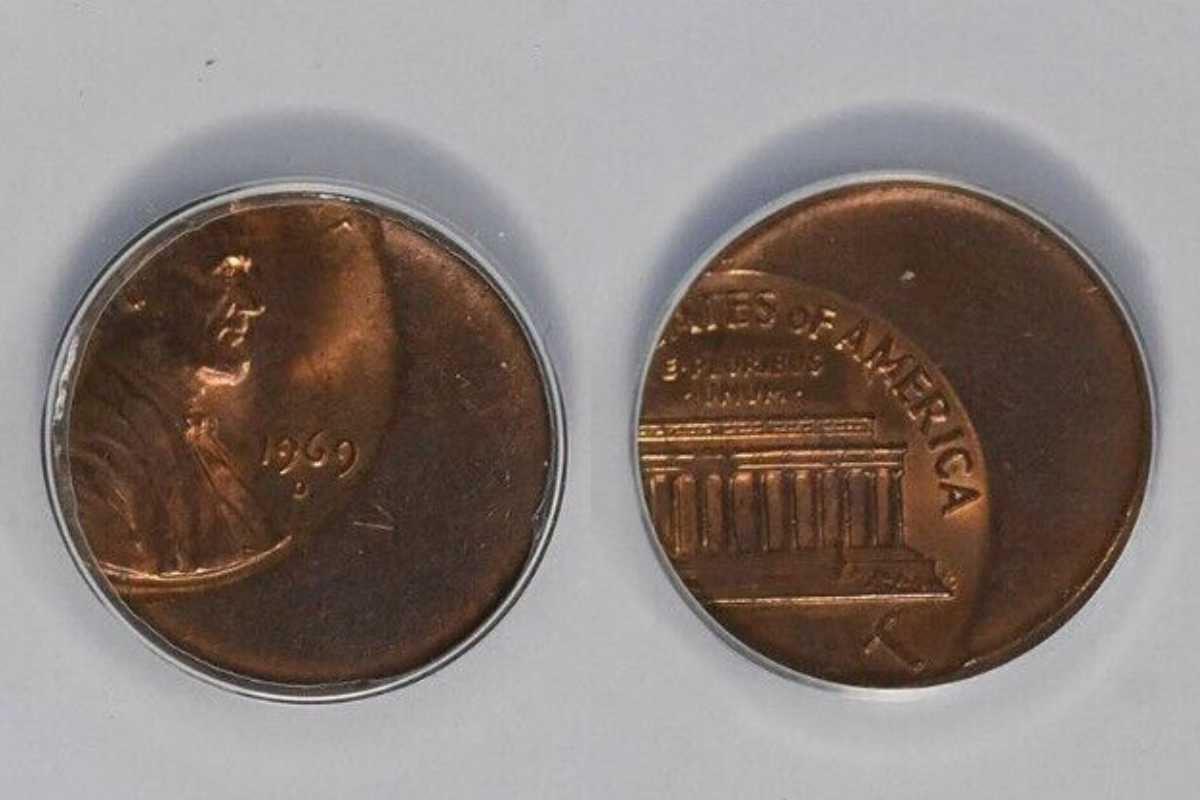
This is a red and brown 40% off-center 1969-D Lincoln penny. The error was a result of incorrect planchet placement in the dies.
At 40% off center, the coin presents with large blank areas on the obverse and reverse. The “IN GOD WE TRUST” motto, and at least half of President Lincoln’s head do not appear on the obverse. On the reverse, the left half of the building isn’t displayed.
The coin is ANACS graded as MS64RB and priced at $54
1969 S Penny with Broad struck, Out of Collar Error
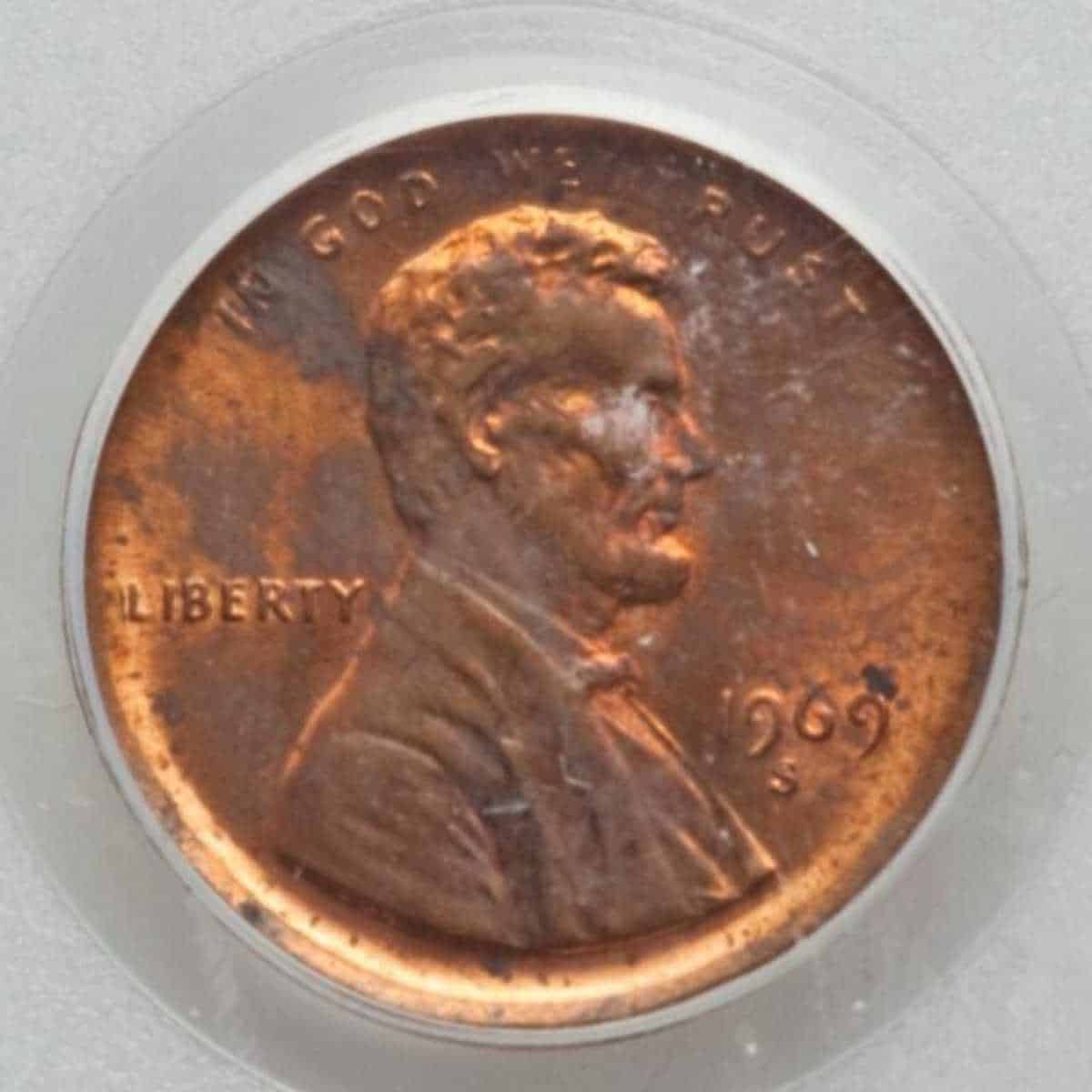
Here is a 1969-S penny with a broad strike error. It is PCGS-certified as MS64RB and priced at $39.
Unlike other error coins on this list, a broad-struck coin has all the elements of the design. The error is in the size, as it is wider and flatter than a normal coin.
A broad strike occurs when the collars that restrain the planchet fail during the die strike. As a result, the coin becomes flattened and expands but still retains the engraving. The weight also remains unchanged.
1969 D Lincoln Penny with Struck 60% off Center Error
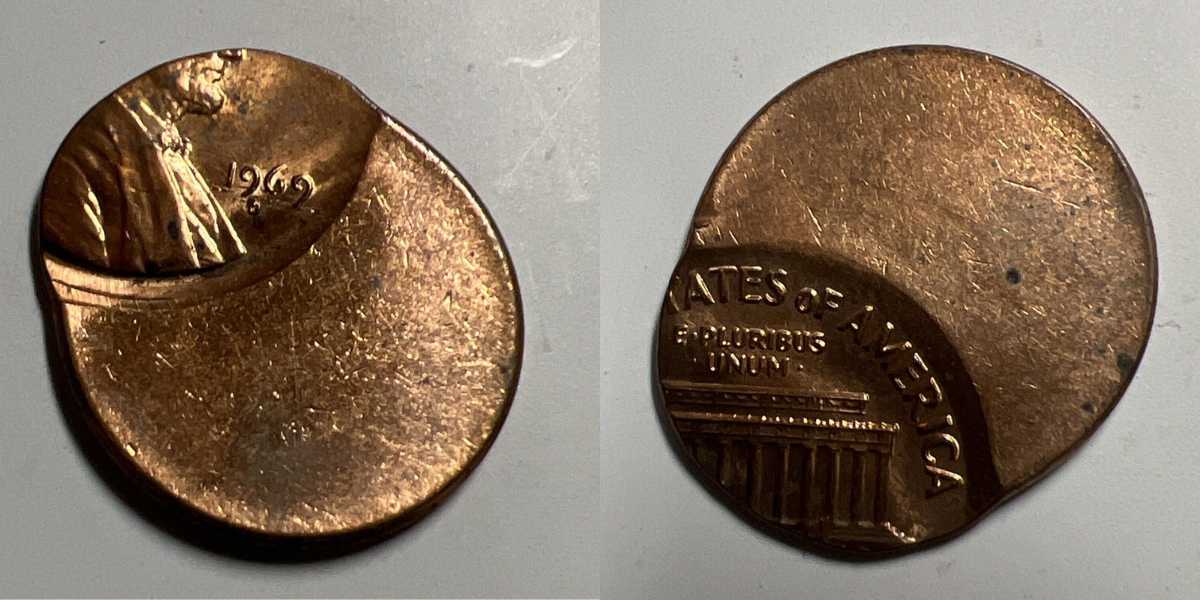
A 1969-D Lincoln cent with 60% off-center strike. Due to the off-center strike, the shape of the coin is altered and looks more oval rather than round.
Only about 40% of the image appears on either side of the coin. On the obverse, only the date and the front half of the president’s face can be seen. The reverse shows half of the building, and the words “OF AMERICA.”
This error 1969 coin is NGC–certified as MS65RB and is worth $444
1969 S Penny with CUD Error (Obverse Die Break)

This is an NGC-certified 1969-S penny with grade AU 55-BN.
The coin has a cud error caused by a broken die. The result is a blob that takes the shape and size of the missing piece. In this case, the blob is at the bottom edge and it covers everything below Lincoln’s shoulder. The coin was priced at $204.


Jenson is a professional numismatist, a dedicated coin collector, a graduate of the College of Business at Oregon State, a life member of the American Numismatic Association (ANA), and an overall coin nerd. He is the founder of Coin Value List.

Hello.. I’d like to get some of my Penny’s..1969S-etc checked out who do I look to for gradeng the coins I’ve many years of the Lincoln coin..so who do i send Pics to???
Hi Micheal, please send to the :[email protected]